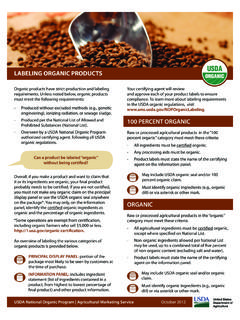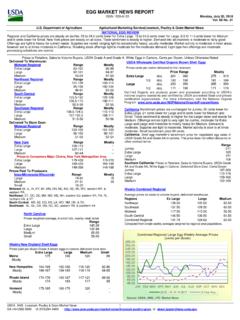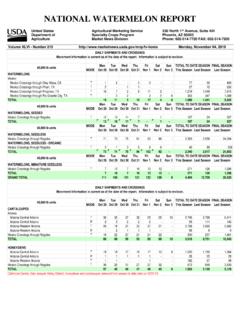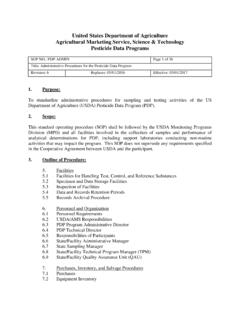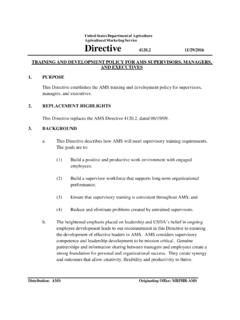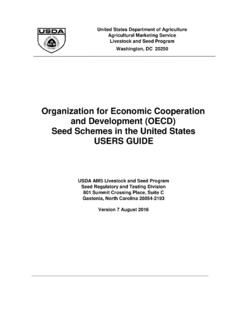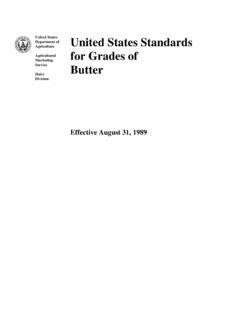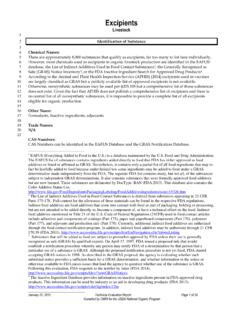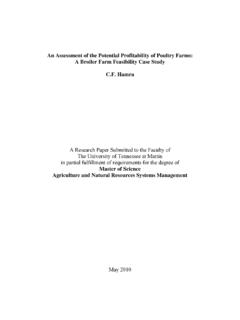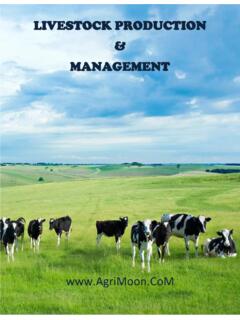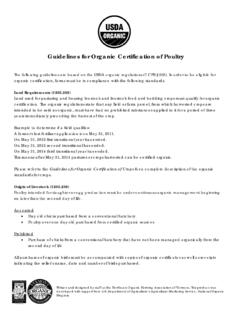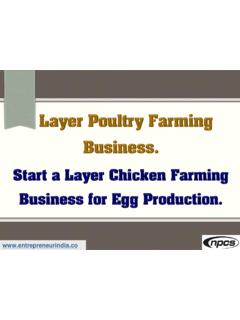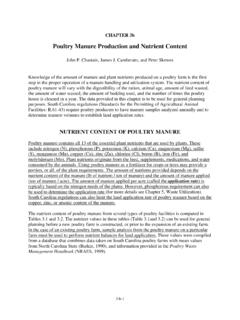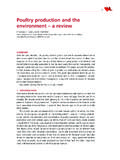Transcription of Organic Production and Handling Standards
1 What is Organic ? Organic is a labeling term that indicates that the food or other agricultural product has been produced and processed using approved methods. These methods integrate cultural, biological, and mechanical practices that foster cycling of resources, promote ecological balance, and conserve biodiversity. Synthetic fertilizers, sewage sludge, irradiation, and genetic engineering may not be used. Who is affected by the USDA Organic regulations?All products that are sold, labeled, or represented as Organic must meet all requirements in the USDA Organic regulations. Products must be certified Organic by a USDA-accredited certifying agent. The USDA Organic regulations ensure that organically labeled products meet consistent national Operations whose gross agricultural income from Organic sales is less than $5,000 do not need to be certified in order to sell, label, or represent their products as Organic .
2 These operations also do not need to prepare an Organic systems plan. However, they must still comply with all other USDA Organic regulations. Exempt operations may use the word Organic , but may not use the USDA Organic seal on their products. Retail food establishments that sell organically produced agricultural products do not need to be certified. What are the USDA Organic requirements?The Organic Standards describe the specific requirements that must be verified by a USDA-accredited certifying agent before products can be labeled Organic . An overview of some of the crops, livestock, and Handling Standards are provided below. Please note that all Organic operations must comply with all requirements in the USDA Organic StandardsThe Organic crop Production Standards require that: Land must have had no prohibited substances applied to it for at least 3 years before the harvest of an Organic crop.
3 Soil fertility and crop nutrients will be managed through tillage and cultivation practices, crop rotations, and cover crops, supplemented with animal and crop waste materials and allowed synthetic materials. Crop pests, weeds, and diseases will be controlled primarily through management practices including physical, mechanical, and biological controls. When these practices are not sufficient, a biological, botanical, or synthetic substance approved for use on the National List may be used. Operations must use Organic seeds and other planting stock when available. The use of genetic engineering, ionizing radiation and sewage sludge is Organic Program | Department of Agriculture | | 202-720-3252 Organic Production and Handling StandardsOrganic Production and Handling Standards (continued)National Organic Program and poultry StandardsLivestock and poultry Standards apply to animals used for meat, milk, eggs, and other animal products sold, labeled, or represented as Organic .
4 Some requirements include: Animals for slaughter must be raised under Organic management from the last third of gestation, or no later than the second day of life for poultry . Producers must feed livestock agricultural feed products that are 100 percent Organic , but they may also provide allowed vitamin and mineral supplements. Dairy animals must be managed organically for at least 12 months in order for milk or dairy products to be sold, labeled or represented as Organic . Preventive management practices must be used to keep animals healthy. Producers may not withhold treatment from sick or injured animals. However, animals treated with a prohibited substance may not be sold as Organic . Ruminants must be out on pasture for the entire grazing season, but for not less than 120 days.
5 These animals must also receive at least 30 percent of their feed, or dry matter intake (DMI), from pasture. All Organic livestock and poultry are required to have access to the outdoors year-round. Animals may only be temporarily confined due to documented environmental or health considerations. Organically raised animals must not be given hormones to promote growth or antibiotics for any reason. Handling StandardsThe Handling Standards require: All non-agricultural ingredients, whether synthetic or non-synthetic, must be allowed according to the National List of Allowed and Prohibited Substances. In a multi-ingredient product labeled as Organic , all agricultural ingredients must be organically produced, unless the ingredient(s) is not commercially available in Organic form and listed on Section Handlers must prevent the commingling of Organic with non- Organic products and protect Organic products from contact with prohibited substances.
6 Labeling Multi-Ingredient Products Products sold, labeled, or represented as Organic must have at least 95 percent certified Organic content. Products sold, labeled, or represented as made with Organic must have at least 70 percent certified Organic content. The USDA Organic seal may not be used on these products. Products containing less than 70 percent Organic content may identify specific ingredients as Organic in the ingredients list. October 2002 Updated November 2016
